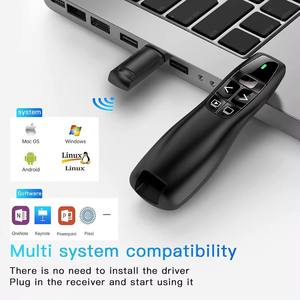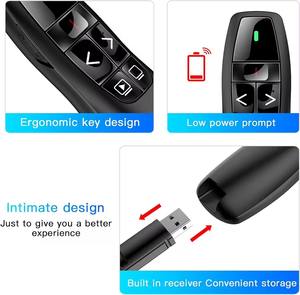(673 products available)



































































































































































































PowerPoint remote controls are commonly used during presentations to control the flow of the presentation, particularly in corporate environments and academic settings. They are designed to allow presenters to move through slides from a distance, change slides, highlight points of interest, and control how the presentation looks and feels. Here are some types of PowerPoint remote controls.
They usually have minimal features, such as moving back and forth between slides, starting and stopping the presentation, and sometimes highlighting or annotating on the screen. These basic models are affordable and straightforward to use. They are usually operated by a USB receiver that plugs into the presenter’s laptop or computer, allowing them to control the presentation wirelessly. They are portable and compact.
These offer more features than the basic models. In addition to the essential functions, they may include a laser pointer for highlighting points on the screen, a timer display to help the presenter keep track of time, and additional controls for navigating through complex slide structures. Some advanced models may also have built-in memory to store presentation files, allowing the presenter to access their slides without needing a separate computer. They are also compatible with more devices.
Some remote controls work hand in hand with specific apps. These apps are designed to provide additional functionality beyond what a traditional remote control can offer. They may allow the presenter to control the presentation from their smartphone or tablet, eliminating the need for a separate remote control device. App-enabled remote controls may include features such as gesture control, voice commands, and the ability to view and annotate on the presentation slides directly from the mobile device. They are quite convenient.
They are designed to work with multiple devices. They may include features such as the ability to switch between controlling the presentation on a computer, a projector, or a smart TV. These remote controls offer versatility, allowing the presenter to use the same device to control different aspects of the presentation setup. They reduce the number of remote controls the presenter needs to carry around.
PowerPoint presentation remotes have various features that make them ideal for presentations. They include the following:
Laser Pointer: Some presentation remotes have built-in laser pointers that help draw attention to specific points. Lasers can be red, green, or blue. Red lasers are the most commonly used, while green and blue lasers are brighter and more visible.
Wireless Option: PowerPoint remotes are wireless, so users can walk around the room, interact with the audience, and control slides. They use either RF or IR technology. RF remotes have a longer range and do not require a direct line of sight to the computer. On the other hand, IR remotes need a direct line of sight to work.
Range: The range of a PowerPoint remote control is an essential factor to consider. It determines the distance from which the presenter can control the slides. Most remotes have a range of between 30 and 100 feet. Some can work from a range of up to 300 feet away.
Compatibility: Most PowerPoint remotes are compatible with various operating systems, including Windows, Android, and iOS. This makes it easy to use them with different devices.
Plug-and-Play: PowerPoint presentation remotes are easy to set up and use. They are plug-and-play, so users can start using them immediately after plugging them into a USB port. The remote will automatically connect to the computer, and users can start controlling the slides right away.
Battery Life: Most PowerPoint remotes have a long battery life. This ensures that the batteries do not run out during a presentation. They also use rechargeable batteries, which are convenient and cost-effective.
Other features that a PowerPoint presentation remote may have are the following:
PowerPoint remote controls find application in various situations across different industries. Some common scenarios include;
When selecting a PowerPoint remote control, people should consider their presentation style and surroundings. The following table will help customers to choose the right PowerPoint remote control.
Q1: How do you use a PowerPoint clicker?
A1: First, one must turn the presenter on and plug the receiver into a USB port. The device will automatically connect. Then, the presenter must open the presentation software and start the slideshow. Next, use the buttons on the presenter to navigate the slides. Finally, after the presentation, turn off the presenter to save battery life.
Q2: Can I connect a PowerPoint clicker to a smartphone or tablet?
A2: It is essential to check the compatibility of the PowerPoint clicker with the smartphone or tablet. Some clickers may require additional apps or software to connect to mobile devices. Generally, clickers with Bluetooth or RF technology are more likely to be compatible with mobile devices.
Q3: How can I ensure the PowerPoint clicker has a stable connection?
A3: To ensure a stable connection, it is essential to place the receiver in a USB port and avoid using USB hubs or extension cables. Additionally, stay within the specified range of the clicker and avoid obstacles that may interfere with the signal. Checking the batteries of the clicker and receiver can also help maintain a stable connection.
Q4: What features should be considered when choosing a PowerPoint clicker?
A4: Features to consider include wireless technology (RF or Bluetooth), range, battery life, compatibility with devices and operating systems, built-inlaser pointer, presentation controls (forward, back, start/stop), and additional features like timer and customizable buttons.
Q5: Can a PowerPoint clicker be used with other presentation software?
A5: Many PowerPoint clickers are compatible with other presentation software, such as Keynote, Google Slides, or Prezi. However, before purchasing, it is essential to check the compatibility of the clicker with the specific presentation software being used.